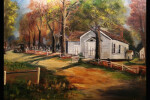A History of Union Chapel, Part 2: 1897 - 1937

Union Chapel is moving into the future. To appreciate where we are going, it is helpful to understand where we've been. Our own Sharon Moore has graciously researched the church's history. The origin of the church can be found here. This is the second installment:
In 1897, two couples joined the Methodist Episcopal Church following a service by the area circuit rider. More couples quickly followed suit during a revival meeting, and Union Chapel was off and running as a Methodist Episcopal congregation.
In 1901, the Union Chapel Cemetery Association was incorporated, assuming the assets and liabilities of the Whitinger Burial Ground. At that time, the trustees for the cemetery were also the trustees for the church. This posed no problem with the church members, as most had interest in the cemetery.
Drawing members from the immediate vicinity, and being the only church in the neighborhood, the congregation quickly began to outgrow the original space. The emergence of the automobile allowed people who lived a distance from the church to attend, as well. The number of children grew to a point that it became difficult to have Sunday School, as the only place big enough for it was the sanctuary. So, to finance the addition of a room to the side of the building, families who owned farms were assessed a proportionate share of the cost.
Over the years, the congregation continued to grow, and the newer families no longer had the same interest in the cemetery as the "old timers." A decision was made to separate the church building from the cemetery and deed the building to the Methodist Episcopal Church. A reincorporation of the cemetery ensured that the original land grant conditions were met, and a deed was issued to Union Chapel Methodist Episcopal Church.
During those early years, Union Chapel was part of a "two-point charge" with Castleton Methodist Episcopal Church, meaning one pastor served both churches. By 1937, the churches were each growing so much that they were separated. Union Chapel finally had its own minister, Rev. J. Lemuel Johnson, and a parsonage was built on Haverstick Road just north of the church.
With a full-time pastor, the church would continue to grow through the decades, sped along by the ever-increasing influx of families moving away from the city and into the suburbs. (To be continued...)

Comments
Login/Register to leave a comment